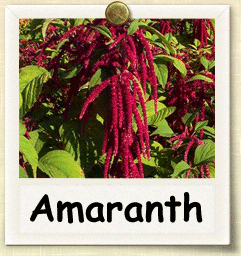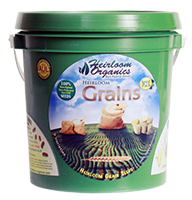|
Home > Guides > Grains > Amaranth |
|
How to Grow Amaranth | Guide to Growing Amaranth |
|
|
|
|
| |
 |
|
Overview |
|
|
|
|
|
| |
|
| |
The amaranth family includes flowers, herbs, and weeds. Some varieties are grown and harvested for food. The seeds of the "Grain Amaranth" were harvested by Aztec and Inca tribes in Central and South America. In Asia and South America Amaranth is cultivated as a grain crop. In the U.S., it can be found in health food stores.
Growing grains is easy and fun! Buy heirloom grain seeds here and start today! See our complete grain growing guide here. Did you know that most grains can be sprouted for high-nutrient super-foods? Try our sprouts packs here with the 3-Day Independence Sprouts Pack. Getting cabin fever? Can't wait to get to that Spring gardening? Grow indoors right now with the Complete Micro Greens Growing Kit or the Micro Greens Seed Pack. Have a high nutrient vegetable garden on your windowsill this week! |
|
| |
|
|
| |
|
|
| |
|
|
|
|
|
|
|
|
|
Well Drained Rich in Nitrogen and Phosperous |
|
|
|
|
|
|
|
|
|
|
|
|
Growing Guide
GROWING NOTES
Amaranth is responsive to nitrogen and phosphorous. Plants grown in average garden soil will be four-feet to six-feet tall, while those grown in rich soil or compost may reach over eight feet. Optimum soil is a well-drained loam but both plants will do well in all but poorly aerated clay soils.
Amaranth are grown from seed. Amaranth seeds can be directly seeded into your flower garden, or started indoors for transplanting later. Note, Amaranth plants are susceptible to frost. Amaranth prefers warm weather. If planting outdoors, sow Amaranth seeds after the soil has begun to warm in the spring.
We recommend an indoor start, six to eight weeks before the last frost in your area.
Sow seeds early in the season and cover lightly with soil. Space seeds or seedlings 10-12" apart. They will tolerate a little crowding, and look good in clumps or groups.
MAINTAINING
Amaranth are very easy to grow. They prefer a warm climate, full sun, and a well drained soil. Water them during dry periods, once or twice per week. Add a general purpose fertilizer once or twice a season.
Originating in warmer climates, Amaranth is heat and drought resistant.
Amaranth will grow tall, 1-2 feet. They will produce of blooms on strong, straight stems. Flowers are long lasting, and will bloom from mid summer until frost.
Amaranth resembles lamb's-quarters and amaranth resembles red-rooted pigweed, especially in the early stages of growth, so it is best to sow seed in rows to make weeding less confusing. Sowing amaranth cultivars with purple leaves also simplifies weeding. Since seed is small, you can avoid considerable thinning by mixing it with sand or radish seed before sowing, as is sometimes done with carrots. Amaranth and quinoa are low-maintenance crops but weeds, especially at the beginning, should be discouraged by cultivation or mulching.
|
|
| |
|
| |
Heirloom seeds are the gardeners choice for seed-saving from year-to-year. Learning to save seeds is easy and fun with these books. Before you harvest, consider which varieties you might want to save seeds from so that your harvesting practice includes plants chosen for seed saving. Be sure to check out our newest seed packs, available now from Heirloom Organics. The Super Food Garden is the most nutrient dense garden you can build and everything you need is right here in one pack. The Genesis Garden s a very popular Bible Garden collection. The Three Sisters Garden was the first example of companion planting in Native American culture. See all of our brand-new seed pack offerings in our store.
|
|
| |
|
|
| |
Harvesting Guide
HARVESTING
Amaranth keeps on flowering until hit by the first hard frost. Seed will often ripen many weeks before that, usually after about three months. The best way to determine if seed is harvestable is to gently but briskly shake or rub the flower heads between your hands and see if the seeds fall readily. (Numerous small and appreciative birds may give hints as to when to start doing this.) An easy way to gather ripe grain is, in dry weather, to bend the plants over a bucket and rub the seedheads between your hands. My own preferred threshing method is to rub the flowerheads through screening into a wheelbarrow and then to blow away the finer chaff using my air compressor. Cutting and hanging plants to dry indoors does not work very well: the plants become extremely bristly and it is difficult to separate the seed from the chaff.
SAVING SEEDS
Harvesting amaranth seeds is a simple process. Cut the seedheads just before they become dry and brittle. Lay the seedheads on a cloth or place them inside paper or cloth bags with heads down and leave in the shade to finish drying. When the seedheads are dry, the seeds can be removed in several ways: by rubbing gently with your hands (wearing gloves is recommended), by enclosing the seedheads between two cloths and treading on top without shoes on, by beating the seedheads inside of a bag, or by beating seedheads together over a cloth. Once the dry seeds are removed they can be placed into a shallow bowl and swirled around until the large pieces of flowers rise to the top where they are easy to remove. By tipping the bowl you can rake out much of the chaff that is left. Any small particles of flowers, chaff, or dirt that remain can be removed by shaking the seed through a small mess screen about the size of window screen. Winnowing the seed in a light breeze will also remove the flower and chaff effectively. The seeds are very light so it is important to winnow carefully in light breeze only.
|
|
| |
|
|
|
| |
|
|
|
|
|
| You can find this variety in the following Seed Packs: |
|
  |
|
| Click the packs below to see some of our other wonderful products |
|
|
|
|
|
|
|